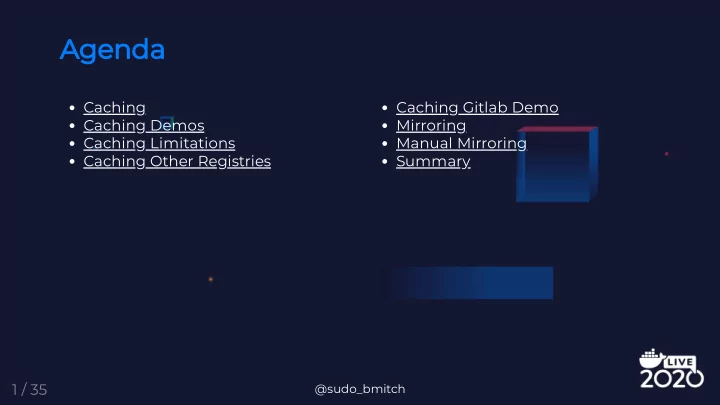

Agenda Caching Caching Gitlab Demo Caching Demos Mirroring Caching Limitations Manual Mirroring Caching Other Registries Summary 1 / 35 @sudo_bmitch
How to Use Mirroring and Caching to Optimize Your Image Registry Brandon Mitchell Twitter: @sudo_bmitch GitHub: sudo-bmitch 2 / 35
Ephemeral Build Server? 3 / 35 @sudo_bmitch
Cluster Pulling Remote Images? 4 / 35 @sudo_bmitch
Worry About Upstream Image Changes? 5 / 35 @sudo_bmitch
Build and Deploy Infrastructure Tolerant of Upstream Outages? 6 / 35 @sudo_bmitch
Production Resilience 7 / 35 @sudo_bmitch
Build Infrastructure 8 / 35 @sudo_bmitch
Build Outage 9 / 35 @sudo_bmitch
Build Resilience 10 / 35 @sudo_bmitch
Faster Builds and Less Bandwidth 11 / 35 @sudo_bmitch
Caching 12 / 35 @sudo_bmitch
Caching is the Easy Button https://commons.wikimedia.org/wiki/File:Easy_button.JPG 13 / 35 @sudo_bmitch
Cache Architecture 14 / 35 @sudo_bmitch
Cache Implementation Either the dockerd CLI: dockerd --registry-mirror <cache-url> Or /etc/docker/daemon.json { "registry-mirrors": [ "<cache-url>" ] } Plus a registry: docker run -e REGISTRY_PROXY_REMOTEURL=<upstream-url> registry:2 15 / 35 @sudo_bmitch
00:00 16 / 35 @sudo_bmitch
00:00 17 / 35 @sudo_bmitch
00:00 18 / 35 @sudo_bmitch
00:00 19 / 35 @sudo_bmitch
00:00 20 / 35 @sudo_bmitch
So What's the Catch? 21 / 35 @sudo_bmitch
Cache Limitations The "registry-mirror" setting only applies to Docker Hub Only caches pulls not pushes Pulls still check the image manifest on Hub Credentials are in the cache server Docker implementation only supports one authentication method 22 / 35 @sudo_bmitch
Options to Cache Other Registries Con�gure a squid HTTP caching proxy Pull directly from the cache Use DNS and TLS certs to send pulls to the proxy 23 / 35 @sudo_bmitch
00:00 24 / 35 @sudo_bmitch
I Want More 25 / 35 @sudo_bmitch
Mirroring 26 / 35 @sudo_bmitch
Mirror Architecture 27 / 35 @sudo_bmitch
Running a Registry Docker image docker container run -p 5000:5000 registry:2 Harbor Many Artifact Repositories 28 / 35 @sudo_bmitch
Manually Mirroring docker image pull ${image} docker image tag ${image} local-mirror:5000/${image} docker image push local-mirror:5000/${image} 29 / 35 @sudo_bmitch
Manual Mirror Script docker image pull "$localimg" docker image pull "$remoteimg" remoteid=$(docker image inspect "$remoteimg" --format '{.Id}') localid=$(docker image inspect "$localimg" --format '{.Id}') if [ "$remoteid" != "$localid" ]; then docker image tag "$localimg" "$localimg.$datestamp" docker image tag "$remoteimg" "$localimg" docker image push "$localimg.$datestamp" docker image push "$localimg" fi 30 / 35 @sudo_bmitch
Why All the Complication? 31 / 35 @sudo_bmitch
Advantages of Manually Mirroring Over Automatically Syncing Repos: Changes to images happen on your schedule Backout option exists with breaking changes Over Pull Through Cache Those reasons plus... Pushing locally built images to the registry Upstream outage doesn't stop local builds/deploys 32 / 35 @sudo_bmitch
Risks of Manually Mirroring Images go stale if you do not automate the script Adding new images is an added process Recovering from a mirror outage requires populating images FROM line in images needs to point to mirror ARG REGISTRY=docker.io FROM ${REGISTRY}/alpine:3.9 ... docker build --build-arg REGISTRY=local-mirror:5000 . 33 / 35 @sudo_bmitch
Summary Both Saves bandwidth Faster builds Pull Through Cache Easy to create Little maintenance Managed Mirror Control changes Tolerate upstream outages 34 / 35 @sudo_bmitch
Thank You github.com/sudo-bmitch/presentations Brandon Mitchell Twitter: @sudo_bmitch GitHub: sudo-bmitch 35 / 35
Recommend
More recommend